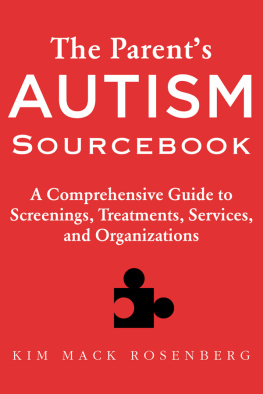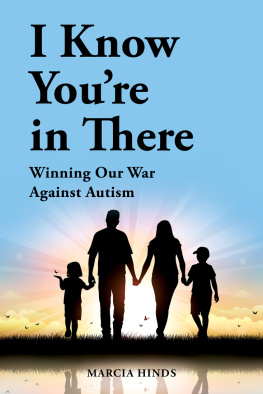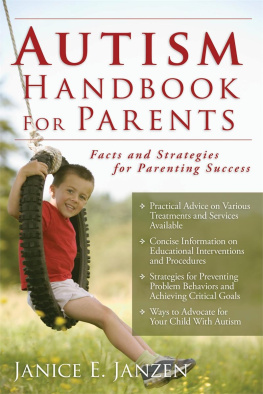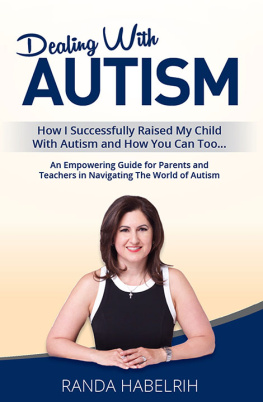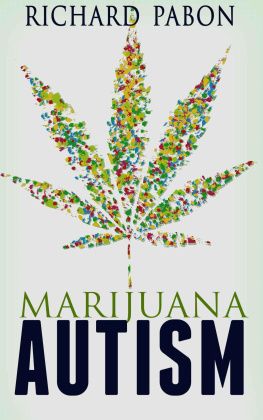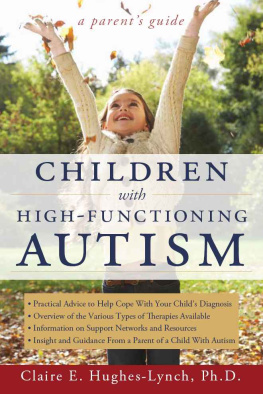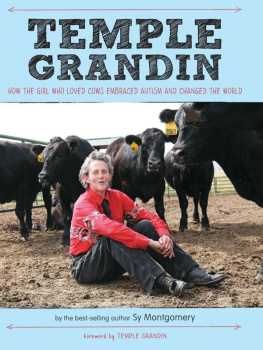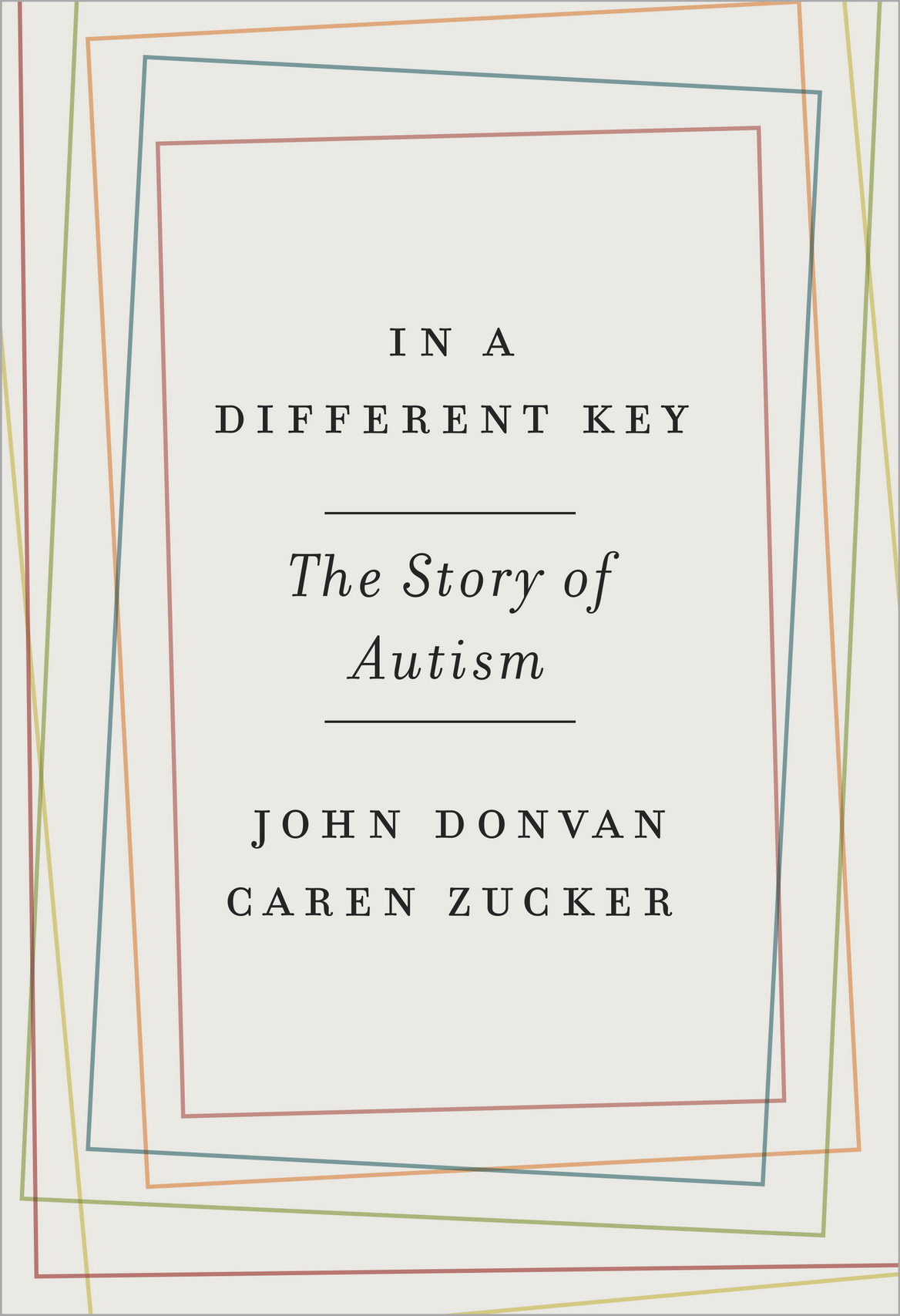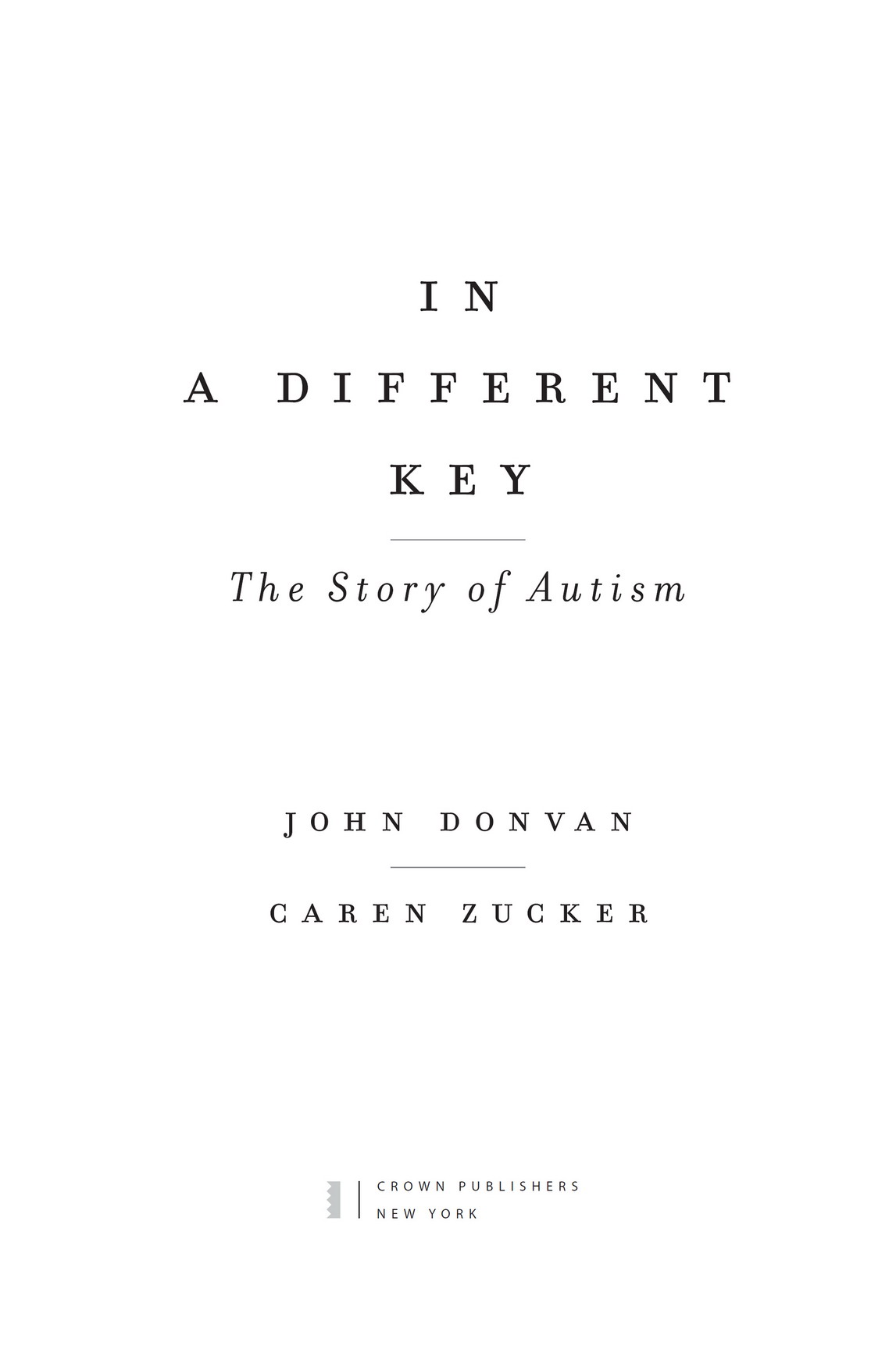Advance Praise for
IN A DIFFERENT KEY
In a Different Key is filled with gripping personal histories that powerfully illustrate the mistakes and malpractices in the diagnosis and treatment of autism; the courage and resilience of those who fought for better treatment and deeper understanding; and the sheer variability of people who are given the autism label and too often lumped together as disabled. A fascinating and revealing read, even for those with no personal connection to the topic.
STEPHANIE COONTZ, author of The Way We Never Were:American Families and the Nostalgia Trap
Bravo to Donvan and brava to Zucker. Comically/tragically, autisms history is as emotionally dysfunctionaland as beautifulas it gets. Finally, we all have an exhaustive reckoning.
MICHAEL JOHN CARLEY, founder, GRASP; author of Aspergers from the Inside Out
Donvan and Zucker delve deep into both the science and the politics of autism across time. They tell the story of the extreme treatments that have been tried, such as administering LSD or electric shocks in the 60s, to normalize these children. They uncover the tragic mercy killing of a teenager with autism by his father, and explore the MMR vaccine-causes-autism theory, named by TIME magazine as top of the list of great science frauds. This book will make a remarkable contribution to the history of autism.
SIMON BARON-COHEN, author of The Essential Difference; director, Autism Research Centre, Cambridge University
Autism is a shape changer that has continuously resisted being pinned down. This meticulously researched book leads us deeply into the history of autism and brings to life the colorful personalities and conflicting ideas that deepen the fascination of autism.
UTA FRITH, Emeritus Professor of Cognitive Development, University College London
Autism remains one of the great medical mysteries of our time and this is the first book to fully document the decades of efforts by parents, doctors, and society to deal with itso far. For, as the authors say, this is a story that is far from over. In a Different Key is a monumental piece of journalism that promises to be a classic, a comprehensive baseline for evidence only future research can reveal. It is written with clarity and grace, and with heart, because the authors have both lived with autism in their own families.
ROBERT MACNEIL, former anchor and cofounder of PBS NewsHour
This one volume captures the textured and sometimes turbulent story of autism in all of its facets: as a scholarly and scientific endeavor, as a political and legal enterprise, as a social movement. Most especially it embeds these developments within the stories of people whose lives defined and shaped the course of autism. In a Different Key is authoritative and utterly absorbing.
JUDITH FAVELL, past president, Developmental Disabilities Division, American Psychological Association
Copyright 2016 by Caren Zucker and John Donvan
All rights reserved.
Published in the United States by Crown Publishers, an imprint of the Crown Publishing Group, a division of Penguin Random House LLC, New York. www.crownpublishing.com
CROWN is a registered trademark and the Crown colophon is a trademark of Penguin Random House LLC.
Library of Congress Cataloging-in-Publication Data
Names: Donvan, John (John Joseph) 1955 author | Zucker, Caren (Caren Brenda) 1961 author.
Title: In a different key: the story of autism / John Donvan and Caren Zucker.
Description: New York: Crown Publishers, [2016]
Identifiers: LCCN 2015024706 | ISBN 9780307985675 (hardback)
ISBN 9780307985682 (ebook)
Subjects: LCSH: Autism spectrum disorders. | Autism spectrum disordersHistory. | People with disabilities. | BISAC: PSYCHOLOGY / Psychopathology / Autism Spectrum Disorders. | PSYCHOLOGY / History. | SOCIAL SCIENCE / People with Disabilities.
Classification: LCC RC553.A88 D67 2016 | DDC 616.85/882dc23 LC record available at http://lccn.loc.gov/2015024706
ISBN9780307985675
eBook ISBN9780307985682
Cover design by Christopher Brand
v4.1
a
For Helen and Frank, for the words,
and Edna, for the spark.
JD
For Jonah, Molly, Mickey, and John,
and Mom and Dad, for everything you taught me.
CZ
CONTENTS
PREFACE
T he men were crying too. All around the theater. In the balcony. In the orchestra seats. On the stage, off to one side, the shows host, Jon Stewart, was seen bringing the back of his hand to his cheek, and swiping at it. Stewart was due to step back on, but for the time being, he joined with the audience, standing and clapping, and letting the moment lastthis tearful, joyful ovation for the kid and the singer in the spotlight, whose duet had just topped everything.
By 2012, Night of Too Many Stars was a New York fixture, an every-eighteen-months benefit for autism, created by Robert and Michelle Smigel. They were close friends of Stewarts, but more important they were the parents of a teenager named Daniel, who had a most challenging form of autism. When Daniel was younger, and at the point where the Smigels realized they could never give him the ability to speakor alter most of the other lasting limitations to his independencethey figured out what they could do. Robert, a longtime writer for and performer on Saturday Night Live, knew almost everybody in comedy. Michelle was a superior organizer and arm-twister.
The first time out, in 2003, by getting their friends to help them put on a show, they raised just under a million dollars for programs that would help people like Daniel get along in life. By 2012, the money was up to eight figures, and the stars invited to perform considered it an honor to be asked. They were big namesfrom George Clooney to Tina Fey to Tom Hanks to Chris Rock to Katy Perry.
It was Katy Perrys duet, on that night in October 2012, that brought the house to tears. The song was Firework, one of her biggest singles ever. But it was the eleven-year-old girl who played piano and sang with her who sparked the outpouring of emotion. Jodi DiPiazza, diagnosed with autism just before turning two, had discovered music early, practiced the piano relentlessly, and idolized Katy Perry. Sitting at a massive baby grand, with Perry standing opposite, Jodi launched into the song, keeping her gaze fixed at some point in space above the keyboard. Though she never once looked up, the whole theater spotted the slight smile when, mid-song, applause broke out for the first time. When they finished the piece, Jodi leapt to her feet and threw her arms around Perry in a long, awkward hug, which everyone there recognized as the expression of a child with autism who was, in that moment, exceedingly happy. That was when everyone cried. And when Robert and Michelle, standing in the wings, knew they had just helped create a moment that would last longer than any they had created on this stage before. They were right. By 2015, more than 9 million people had watched the DiPiazza-Perry duet online.


